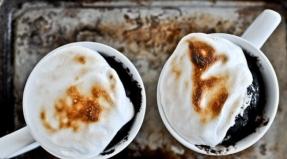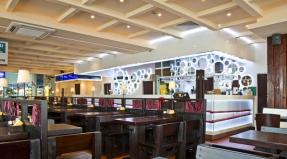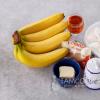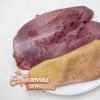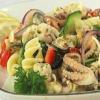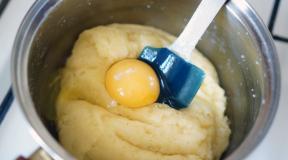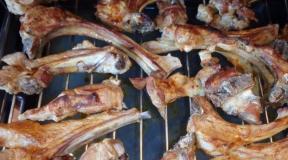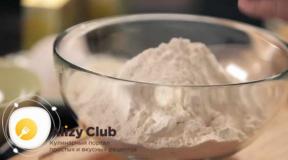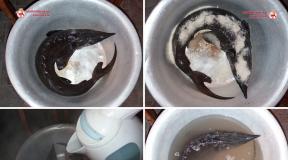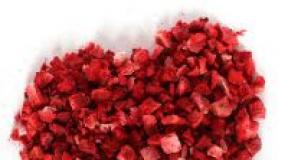Trading House Borodinsky. Bakery and confectionery equipment
Gingerbread (manufacturing technology)
Gingerbread - flour confectionery products of various shapes, containing significant amounts of sugary substances and spices. There are two types of gingerbread: custard and raw. All types of gingerbread can be produced with or without filling. Glazing with sugar syrup, chocolate icing, sprinkling with granulated sugar, poppy seeds, etc. are used for decoration. At present, large enterprises produce gingerbread on flow-mechanized lines.
The technological scheme for the production of raw gingerbread consists of the following operations: preparation of raw materials, dough kneading, molding, baking, cooling, finishing and packaging. In the production of custard gingerbread, dough kneading is preceded by the stages of preparation and cooling of the custard.
Raw gingerbread dough contains a significant amount of sugar, which limits the swelling of flour proteins and contributes to the formation of a loose, viscous dough. The dough is kneaded in drum kneaders with U-shaped blades or in universal kneaders with Z-shaped blades. Raw materials are loaded into the machine in a certain sequence: granulated sugar, water, honey, molasses, invert syrup, melange, essence, chemical baking powder, and finally flour is added. All raw materials, without flour and chemical baking powder, are mixed for 2 ... 10 minutes, which ensures the dissolution of sugar and uniform mixing of the raw materials, after which chemical baking powder is introduced in the form of an aqueous solution and flour. The duration of dough kneading is 5 ... 12 minutes and depends on the temperature conditions of the workshop, water temperature, shaft speed and capacity of the kneading machine. Semi-finished products obtained by heating (sugar, invert syrup, zhenka, etc.) are cooled to 20 ° C before being introduced into the machine. The temperature of the finished dough should not exceed 20 ... 22 ° C, and the moisture content - 23.5 ... 25.5%.
Preparation of choux gingerbread dough consists of three phases: brewing flour in sugar-honey, sugar-treacle or sugar-treacle-honey syrup; cooling the brew and kneading the dough. The brew is prepared as follows. In an open digester, granulated sugar, honey, molasses are mixed at a temperature of 70 ... 75 ° C until the granulated sugar is completely dissolved. The resulting syrup is fed into a kneading machine and flour is added at a temperature not lower than 65 ° C. The brewed mass is stirred for 10 ... 15 minutes and cooled to a temperature of 25 ... 27 ° C, for this cold water is supplied to the water jacket. The moisture content in the brew should be no higher than 19 ... 20%. The rest of the raw materials are added to the chilled brew and the dough is kneaded for 10...60 minutes. The duration of the kneading depends on the speed of the kneading shaft. The temperature of the finished dough is 29...30 °C and the moisture content is 20...22%.
Gingerbread dough is formed mainly on FPL jigging machines, which work as follows. The dough from the funnel is captured by two corrugated rollers rotating towards each other and forced through templates with a cutout of various contours. With the help of a metal string, workpieces are cut off from the dough bundles, which are laid in rows on stencils or on a steel tape of the oven. Gingerbread dough is also molded by hand using a variety of devices (metal recesses or wooden molds).
Gingerbread is baked mainly in continuous conveyor ovens. The duration of baking is 7...12 minutes at a temperature of about 200...240 °C.
After baking, the gingerbread is cooled for 20-22 minutes until
40 ... 45 "C, after which they are removed from the hearth and finally cooled.
In order to preserve freshness, reduce the rate of staleness of gingerbread and improve taste, they are subjected to glazing. This operation consists in the fact that a layer of sugar syrup is applied to the surface of the gingerbread, in which sucrose crystallizes after cooling. A glossy, marble-like crust forms on the surface of the gingerbread. Gingerbread cookies are glazed periodically in coating pans or in continuous units.
Ready-made gingerbread is packed in corrugated cardboard, plywood or plank boxes. Some of the gingerbread is packed in boxes.
Shelf life of gingerbread in dry, ventilated rooms with a temperature of 18 ° C and relative humidity
65...75% is 10...45 days depending on the type of gingerbread.
During student vacations, Dasha and Oksana, who studied in the same group, decided to earn money. Since an uncle worked for one of the students at the local covered market, who had places for selling confectionery goods (mainly cookies and gingerbread), they, by agreement, took the jobs of sellers for a period of 2 months.
In the first weeks, the girls mastered a new profession, which was close to them in their main specialty (they studied at the university at the Faculty of Management and Economics). Then, after consulting, we decided to collect materials for term papers and dissertations - we studied the most popular assortment, the demand for certain types of products, the sensitivity of buyers to price increases or decreases, discounts for regular customers, and supply channels.
The emergence of the idea of own business
Collecting materials and studying suppliers, the conditions for renting places on the market and the most popular goods, the girls came to the conclusion that they themselves could become business owners, earning good money selling gingerbread and cookies. This opinion was brought to them by the reality in which they worked during the days of student vacations and industrial practice.
Daria and Oksana noticed that many goods are brought to the market by semi-legal manufacturers. Part of the production was unaccounted for, and a smaller share of goods passed through official papers than unaccounted for. This made it possible not only to pay for the rent of a trading place, but also to make good money on trading.
If you do not register at first your enterprise, which can produce gingerbread and cookies, then the profitability of the business will be very high. That is, for a ruble invested in a business, it will be possible to receive 2-2.5 rubles of return. Moreover, the payback of the combined production and trade business will be within 5-6 months. After working “in the gray” for 6-8 months and getting on your feet, it will be possible to register a business and pay all taxes due.
Prerequisites for a successful business:
– the co-founders of the new enterprise managed to really work in the system of retail trade in cookies and gingerbread, got to know people, know the situation on the market;
– the co-founders of the business have studied the demand and market conditions, they know many buyers personally, their preferences, optimal prices, the average check value;
– partners in the future enterprise studied logistics, the system for delivering products from the manufacturer to the consumer, warehousing, delivery and acceptance, and the system of remuneration for forwarding drivers;
- the co-founders are aware of several cafes in which business is progressing with great difficulty and their owners will gladly take up the production of cookies and gingerbread on favorable terms.
Production and production equipment
For the profitable operation of the enterprise, it is necessary to have its own production equipment, which will ensure independent and continuous work on the manufacture and sale of confectionery products.
Of course, it is also possible to buy part of the products from legal or semi-legal manufacturers (with all certificates of conformity and details of the manufacturer). But this is a less profitable business, since own production will give 50-60% more profit.
As the main means of production, a unit for the production of cookies or gingerbread with a capacity of 600-800 kg per shift (in the first 2-3 months) is selected, with a subsequent increase in productivity and shift ratio.
The cost of new equipment is 2-2.5 million rubles. for a set that was in use - about 1 million rubles.
After studying this issue, the co-founders of the business chose a unit on the Internet, which is designed to form dough pieces from gingerbread (oatmeal) or other dough close to it in properties, by pushing it with corrugated rollers through the nozzles of matrices of various configurations and then cutting the dough bundles into separate pieces by a mechanism string cutting.
Such a unit is used in confectionery shops of cafes and bakeries of small capacity in the production of gingerbread, oatmeal cookies of various recipes of round and oval shapes, cookies "Oatmeal", "Mosaic", "Leaflets", etc. By a separate order, this machine can be equipped with matrices for making gingerbread and cookies of various shapes.
The mass of the machine is 400 kg, overall dimensions are 2300 x 950 x 1480 mm, power is 0.5 kW. Productivity 200-500 kg per hour.
Financial conditions
It was decided to purchase a unit for the production of gingerbread and cookies at the expense of a bank loan in the amount of 2 million rubles. for a period of one year at 22% per annum. Along with Daria and Oksana, Andrey, the owner of the cafe, entered the business (there are preliminary agreements with him). Andrey places the unit in the production shop of the cafe and provides maintenance personnel (2 staff positions).
Finished products will be shipped to several retail outlets located in the markets and to roadside kiosks. For the transportation of gingerbread and cookies, forwarding drivers will be involved, who carry out similar operations for other sellers and manufacturers of confectionery products.
Pricing policy and quality
Retail prices for cookies and gingerbread produced will be practically the same as for similar products from other sellers with a possible reduction of 5% (to intensify demand). The quality of these food products will be maintained at a fairly good level by maintaining production regulations, recipes and the quality of raw materials.
According to the co-founders of the business, for buyers of gingerbread and cookies, the main buying factors are the price and freshness of products, which usually vary in small ranges. The price, as a rule, keeps at the given levels for several months. The freshness of gingerbread and cookies is considered quite sufficient within 3 days.
Usually, the average prices for cookies and gingerbread of different varieties range from 70 to 140 rubles. per kilogram. The difference between wholesale and retail prices is 10-14%.
With the independent production of gingerbread and cookies, without paying taxes and social payments, with the sub-hiring of unaccounted personnel, the profitability of production increases by 5-6 times. Each produced and sold kilogram of cookies and gingerbread is capable of bringing from 30 to 60 rubles. net profit.
Package
Manufactured products are planned to be packed in cardboard boxes of standard size. In retail sales, boxes packed with adhesive tape are opened and weighed for buyers in plastic bags (costing 30-50 kopecks - depending on the volume). Packaging bags are purchased in bulk from specialist retailers.
Payment Methods
Payment for the sold goods goes to the founders of the business in cash. Cash registers are not used in the sale of cookies and gingerbread. The joint profit is divided between Daria and Oksana in the proportion of 50:50%.
Business development
At the beginning of the construction of the trade and production chain, Daria and Oksana act as individual entrepreneurs renting trading places in food markets. The number of hired sales personnel will initially be 4-5 units.
After the preliminary development of all trade and production operations, repayment of the loan and interest on it, it is planned to register our own LLC in the trade and production sector.
The full payback of the business should occur within a period of up to 6 months. After that, the company will generate net income, which will allow it to expand the business, hire new staff, create its own recipes and food products.
Gingerbread confectionery products of various shapes, containing a significant amount of sugary substances and mostly various spices. The group of gingerbread also includes gingerbread, which is a baked semi-finished product made of gingerbread dough, layered mainly with fruit filling or jam, having a rectangular flat shape. There are two main types of gingerbread: custard and raw. All types of gingerbread can be made with or without filling.
Gingerbreads are produced with various external finishes: glazing with sugar syrup with and without additives, chocolate icing, sprinkling with sugar, poppy seeds, and nut kernels.
Gingerbread was produced even before the use of beet sugar using honey. And now honey is widely used as one of the main raw materials. In many cities, they specialized in the development of certain varieties. This became the basis for the names of some types of gingerbread: "Tula", "Vyazemsky". Currently, at large confectionery enterprises, gingerbread is produced on flow-mechanized lines. On fig. 1 shows a diagram of a line for the production of custard glazed gingerbread.
Rice. 1. Technological scheme for the production of gingerbread
Flour from container 1 is sifted in burat 2 and bucket elevator 4 is fed into hopper 5 of automatic scales 6. An auger 3 is used to transfer flour from the hopper to the scales. A weighed portion of flour for welding enters the kneading machine 7, into which hot sugar or sugar honey syrup. The resulting brew after cooling is mixed with other types of raw materials and flour. The dough on the 8 trolley goes to the 9 molding machine. The molded dough pieces are sent to the 10 oven, then to the 11 cooling cabinet and are fed by the 12 conveyor for further cooling to the 13 conveyor. syrup. Gingerbreads covered with syrup enter the 16 dryer and 17 stacking conveyor, where they are packed into containers.
The technology for obtaining raw gingerbread is simpler than custard. In their production, the operation for the manufacture of welding is excluded. All raw materials specified in the recipe, except flour, are loaded into a kneading machine and mixed. Then flour is added and the dough is kneaded. The operations of molding and baking are not fundamentally different from the same operations in the production of custard gingerbread. Many varieties of raw gingerbread are produced without glazing. After baking, they are cooled and immediately packed in containers.
The dough for raw gingerbread is prepared in kneading machines of various designs: in drum kneaders with U-shaped blades mounted on a shaft, or in universal kneaders with Z-shaped blades rotating towards one another.
All raw materials specified in the recipe are weighed and loaded into the kneading machine in the following sequence: sugar, water, honey, molasses, invert syrup, melange, essence, dry perfume, baking powder and, last but not least, flour. If sugar is introduced in the form of sugar syrup prepared in advance, then the kneading process is carried out in two stages. First, all raw materials are loaded without flour and baking powder and mixed for 1-2 minutes, and then after the introduction of baking powder and flour, they are mixed for another 5-12 minutes.
The duration of the batch is adjusted depending on the air temperature in the workshop, water temperature, speed and capacity of the kneader. At elevated air temperatures in the workshop and water, as well as with an increase in the rotational speed of the kneading organs, the kneading time is reduced. With an increase in the capacity of the kneading machine and, accordingly, the mass of the load, the duration of the batch is increased. The kneading is stopped when the mass becomes homogeneous with a uniform distribution of all raw materials. Baking powder is introduced in the form of an aqueous solution, which is prepared in advance. Semi-finished products, the preparation of which is associated with heating (sugar, sugar-watering and invert syrup, zhenka), are cooled to a temperature not exceeding 20 ° C before being introduced into the kneading machine. Water should also not have a temperature higher than 20 ° C. In all cases, the temperature of the finished dough should not should exceed 20-22 ° C, and the humidity should be in the range of 23.5-25.5%.
The increased temperature of the dough leads to its tightening, a process in which the gluten of the flour, interacting with water, gives the dough elastic properties. As a result, the shape of the products is broken.
When making dough for gingerbread "Tulskie" and "Vyazemskie", sugar-honey syrup is first prepared, then it is cooled to 30-35 ° C, all raw materials, including flour, are kneaded for 30-40 minutes. The final temperature of the dough should be 27-28 ° C, and its humidity should be 18-20%.
To increase the shelf life of raw gingerbread, instead of sugar, invert syrup or artificial honey is used and 50% of wheat flour is replaced with rye flour. When kneading dough, flour is introduced before the rest of the raw materials and chemical baking powder. The total duration of the kneading is more than 1 hour, the humidity of the dough is 15-16%.
The process of kneading dough for custard gingerbread is divided into three stages: brewing flour, cooling the brew and kneading the brew with all components.
Welding flour is carried out as follows. Sugar components are loaded into the digester: sugar, molasses, honey and water in the amount necessary to obtain a certain moisture content (19-20%). The calculation is carried out according to the formula (8-1), taking A equal to 20. When all the sugar is dissolved, the syrup is loaded into a kneading machine with a water jacket, cooled to a temperature not lower than 68 ° C and gradually, with stirring, a part of the flour is introduced, intended for making tea leaves. After 10-15 minutes, the tea leaves are ready. It should not contain lumps and traces of unmixed. Welding is cooled in two ways. If its kneading machine has a water jacket and there are enough kneading capacities in the workshop, then cooling is carried out without unloading the tea leaves from the machine, while cold water circulates in the water jacket. Another way is to unload the tea leaves from the kneading machine into special chests or boxes. The tea leaves are unloaded in layers, the layer is sprinkled with crumbs or lubricated with vegetable oil and cooled in a room at an air temperature of 10-15 ° C. The first method has a number of advantages: cooling is much faster, there is no need to move the tea leaves from the kneading machine h-special containers and have a separate room for cooling. When cooling in boxes or chests, this takes a long time.
With proper and sufficient cooling of the welding, the high quality of the finished product is ensured. From insufficiently chilled tea leaves, gingerbread is obtained dense, irregular in shape. The cooled brew should have a temperature of 25-27 ° C. If cooling is carried out directly in the kneading machine, then at 28-30 ° C the rest of the raw materials are introduced into the brew. In this case, the kneading time is minimal and is only 10 minutes. When using tea leaves that are not cooled in a kneader, the kneading time is significantly increased, and depending on the speed of the kneading shaft, it is 30-60 minutes.
Gingerbread dough is molded on forming-jigging machines. Some types of gingerbread are molded using metal and wooden molds. Gingerbread molded into wooden molds is called printed gingerbread. Such gingerbread is mainly intended for children, so the shapes have the outlines of birds, fish and various animals. When forming such gingerbread, the dough is pressed manually or with the help of special wooden blocks into a wooden mold. The resulting dough piece is removed from the mold and sent to baking on a metal sheet.
When making gingerbread with filling, some part of the dough (about 50%) is rolled out with a rolling pin into a layer and spread with filling. A molded layer of dough extracted from a wooden mold is placed on top of the filling. Without disturbing the pattern, both layers of dough are connected at the edges so that the filling is inside. The resulting puff pastry containing the filling inside is sent for baking. When molding some varieties of gingerbread, a blank is placed in a wooden mold-stencil, consisting of two layers of rolled dough, between which a layer of filling is previously placed. Wooden stencil forms are pre-lubricated with vegetable oil. This facilitates the release of molded dough pieces from the moulds. Dough for gingerbread and loaves is formed by rolling into a layer. The thickness of the workpiece for gingerbread is 11-13 mm, and for long loaves 7-8 mm. The rolled layer, intended for loaves, is cut into strips. The thickness of dough pieces for custard gingerbread is maintained within 8-11 mm, and for raw gingerbread - 10-13 mm.
Round-shaped gingerbread is molded on a FAK-1-brand jigging machine. In addition to gingerbread, sugar biscuits of various varieties and shapes can be molded on this machine. The jigging mechanism works as follows. The dough to be molded enters the hopper and falls into the gap between two rollers. One roll not only rotates, but also moves. When moving, the gap between the rollers decreases, and the dough is forced and pressed out through a flexible hose and a forming matrix. The matrix can move in a horizontal plane and at the same time give the workpiece a different configuration.
The FAK-1 jigging machine operates in different modes depending on the consistency of the dough. When molding the liquid dough, it is deposited in separate doses. The rolls, after approaching and injecting a dose of dough, stop moving. When molding thick varieties, the dough comes out in the form of bundles. Cutting the bundles into slices is done by a moving string.
Water of a certain temperature circulates in the jacket of the walls of the hopper and matrices, which makes it possible to maintain the specified temperature of the dough during its molding.
Gingerbread baking is mainly carried out in continuous conveyor ovens. The duration of baking is 7-12 minutes at a temperature of about 200-240 ° C. Gingerbreads of the “Mint” type, which are not glazed, are baked at lower temperatures (190-210 ° C) in order to avoid the appearance of a dark color on their surface. Gingerbread "Tulskie" is baked at a higher temperature (265-270 ° C) for 5-6 minutes. Dough pieces pass through the humidification chamber before baking.
Gingerbreads and loaves are baked at a temperature of about 200 ° C (loaves for 12-15 minutes, gingerbread 25-40 minutes). When baking gingerbread, basically the same processes take place as when baking cookies. However, the significantly increased duration and relatively low temperatures of baking gingerbread are associated with an increased thickness of the dough pieces used in their manufacture.
After baking, the gingerbread cookies are cooled for 20-22 minutes to 40-45 ° C. When baking on steel meshes or ribbons, the gingerbread cookies are cooled without removing them directly from these surfaces. Gingerbread cookies are removed only when they are easily separated from the grid or steel tape. When baking on stencil sheets, when leaving the oven, they are installed together with products on shelves or fixed racks. After such pre-cooling, the products are easily removed and sent for final cooling. During the cooling process, the moisture content of the gingerbread decreases significantly as the temperature decreases.
Most varieties of gingerbread are finished. Gingerbread finishing is understood as covering the surface with a layer of crystallized sugar. This operation is called glazing. As a result of this operation, the surface of the gingerbread is covered with a glossy, marble-like crust of crystallized sugar. Glazing is done in the following way. Up to 20 kg of gingerbread are loaded into the dragee boiler and poured with sugar syrup having a temperature of 85-95°C. Gingerbreads are processed in a coating pan for 1-2 minutes, then they are unloaded and dried at a temperature of about 60°C. In this case, the speed of movement of the cooling air should be close to 4 m/s. After drying the gingerbread for 9-10 minutes, they are additionally cooled by blowing air at the same speed, but at a temperature of 20-22°C. At mechanized enterprises, gingerbread is glazed in continuous units. This unit is a drum rotating on a horizontal axis, inside which gingerbread is continuously loaded and syrup is supplied. The duration of the process is reduced to 50-60 s. After cooling, the surface of the gingerbread acquires a shine from the sugar crystallized from the syrup. The layer of sugar contributes to the preservation of freshness and delays staling, in addition, after glazing, the taste of gingerbread improves.
Gingerbread is packed in corrugated cardboard, plywood or plank boxes. At the same time, small gingerbread with more than 30 pieces. 1 kg is packed in bulk, the rest is placed in boxes and boxes. A number of gingerbread cookies are pre-packed in boxes.
Gingerbread is stored in well-ventilated, dry, clean warehouses, not infested with granary pests. During storage, the temperature should not exceed 18°C, and the relative humidity of the air should be 65-75%.
Under these conditions, the following storage periods are established for gingerbread: for raw unglazed, except mint, 20 days, mint type in summer 10, and in winter 15 days, for raw glazed 30 days, for custard gingerbread 45 days.


Gingerbread is a very popular product in Russia. The volumes of production of various types of gingerbread are comparable to the volume of production of all types of butter and shortbread cookies taken together. Very popular as usual gingerbread without filling, and gingerbread with filling various forms.
Many manufacturers of confectionery products are interested in the production of gingerbread to expand the existing range, so let's look at what gingerbread is and how they are produced.
First of all, gingerbread is divided into raw and custard. The technology of their production is different in that when kneading the dough, the flour is brewed in sugar-honey or sugar-syrup syrup. For the preparation of raw gingerbread, dough brewing is not required.
However, due to differences in dough manufacturing technology, custard and raw gingerbread differ significantly in taste and shelf life. Custard gingerbread is tastier and stays soft longer. In order to extend the shelf life of raw gingerbread, part of the flour for kneading is often replaced with rye flour, and sugar is reduced, replacing it with invert syrup (less often honey).
Also, to improve the taste and give individuality, fruit and berry powders or condensed milk are often introduced into the recipe.
Both raw and custard gingerbread come with or without filling. As a filling, various fruit and berry purees, jams or jams are most often used. Also use boiled condensed milk. When choosing a filling, it is important to remember that gingerbread cookies are baked at high temperatures and, accordingly, the fillings must be heat-resistant. If you use a non-heat-resistant filling, then during baking, the filling will boil inside the gingerbread, which will at least lead to the absorption of moisture from the filling into the walls of the gingerbread (there will be a void instead of the filling in the gingerbread) or if there is a lot of filling, then the blanks will tear both at the bottom and from above .
Now let's look directly technological process for the production of gingerbread. The technological process can be continuous (in the case of using a tunnel oven and a cooling conveyor) or periodic.
In any case, the technology will be divided into the following stages:
- preparation of raw materials for production,
- dough preparation
- molding,
- bakery products,
- cooling,
- glazing,
- package.
Preparation of dough for the production of gingerbread.
The preparation of the dough is carried out in dough mixers and consists of the preparation of an emulsion and the preparation of the actual dough.
The preparation of the emulsion consists in preparing and mixing in a dough mixer or mixer (with heating) all components except flour and improvers (if used in the recipe). The mixture of raw materials is mixed until complete dissolution of granulated sugar and heated to 65 ... 70 ° C. Ready syrup is cooled down to 50...65°С when making custard gingerbread and up to 30...40°С for raw gingerbread.
In principle, the emulsion can also be prepared in a tempering vessel (digester) with a stirrer, the main thing is to maintain the set temperatures in the dough mixer when adding flour.
When preparing raw dough without syrup, one should strictly observe the order of loading raw materials into a dough mixer: granulated sugar, water, the temperature of which is 20 ° C, honey, molasses, melange, flavors, chemical baking powder and wheat flour.
All raw materials, except for flour and baking powder, are mixed for 2 ... 10 minutes. After preparing the emulsion, flour with baking powder is introduced. The batch is made within 4... 12 min. The dough kneading time depends on the temperature in the workshop, the temperature of the water during kneading, the speed of rotation of the blades and the volume of the dough mixer.
The dough is considered ready when the mass becomes homogeneous with a uniform distribution of all raw materials. The temperature of the finished dough should not be higher than 20 ... 22 ° C. If the dough is hot or it is kneaded longer, the dough will turn out to be tight, which will make it difficult to further mold and bake the products. Also, a gingerbread made from a long dough is stored worse, as it has a tendency to stale.
Humidity raw dough - about 23.5 ... 25.5%.
To prepare the custard dough, the stages of preparation of the custard and its cooling are additionally introduced. The prepared syrup with a temperature of 50 ... 65 ° C is fed into the dough mixer with a shirt (heated). When the dough mixer is turned on, all the flour is gradually introduced into the tea leaves (quantity depending on the recipe). The duration of the brewing kneading depends on the speed of rotation of the dough mixer blades and averages 5 ... 15 minutes. Brewing temperature -48...53°С, humidity - 19...20%.
The brew can be cooled by transferring it to a separate bowl, or into buckets directly in the workshop to a temperature of 25-27 ° C, or if the dough mixer has a flowing water jacket, then right in it by supplying cold water to it.
Proper cooling of the welding is very important for the quality of the finished product. From insufficiently cooled tea leaves, gingerbread is obtained more dense and irregular in shape.
To prepare the dough, chilled tea leaves and all other raw materials provided for in the recipe are loaded into the dough mixing machine. The dough kneading is carried out for 30 ... 60 minutes and depends on the method of cooling the tea leaves, its aging, the speed of rotation of the mixer blades, as well as the temperature of the chilled tea leaves. In the case of cooling the tea leaves in the mixer, the raw materials provided for in the recipe are added to it, and the batch lasts only 10 minutes.
The temperature of the finished dough should be about 28 ... 36 ° C, humidity depending on the variety - 18 ... 23%.
Molding gingerbread
To form the gingerbread, the dough is loaded into a dough depositor. To obtain a dome without filling, a simple jigging machine with dough roller injection and string cutting is used. In this case, the size and shape depend on the shape of the nozzles installed on the jigging machine. To obtain domes with filling, a double-bunker machine with diaphragm cutting is used. On such a machine, it is possible to produce products with and without filling. At the same time, it should be noted that custard dough, due to its consistency, is more difficult to deposit on roller machines. For custard dough, it is recommended to use screw injection, because. it is more efficient and allows you to get more performance.
At this stage of production, differences appear for continuous or cyclic production.
Continuous production of gingerbread.
For continuous production, the steps associated with manual work are almost over, since after loading the dough into the depositor, it is often enough to turn on the depositor and adjust the size of the workpieces. Next, the molded blanks enter the tunnel oven, then the baked gingerbread blanks must enter the air-cooled section of the tunnel. There, the gingerbread is pre-cooled to 40 degrees. This is the most favorable temperature for glazing gingerbread with sugar syrup. If the workpiece is colder, then incorrect crystallization of sugar and further shedding of the glaze is possible. If the glazing of the gingerbread is carried out at a higher temperature of the blanks, then uneven hardening of the icing is possible.
The cooled gingerbread is fed into the drum for replicating gingerbread. There, the gingerbreads, rolling along the inner screw of the drum, move towards the outlet nozzle, while crumbling in the glazing syrup. Drums may vary in design. So they are ordinary (syrup is poured into the drum manually as it works) and with its own supply of syrup. Most often, such a supply is a container of 10-25 liters with a heated jacket (sometimes without it), a syrup supply valve and a tube that delivers the syrup into the drum.
Drying gingerbread.
After glazing, the gingerbread is fed to a multi-tiered conveyor, where the gingerbread is dried. I want to note that the gingerbread should be dried and not cooled. The conveyor for drying gingerbread can be equipped with fans for blowing gingerbread, or drying takes place without blowing. The drying period for gingerbread should be about 40-60 minutes, depending on the size of the gingerbread, the composition of the syrup, and the presence of airflow.
Dried gingerbread has a characteristic color caused by local crystallization of sugar during drying. Glazing the gingerbread, in addition to giving the product a characteristic appearance, also allows the gingerbread to retain moisture longer, thereby extending the shelf life of the product.
The last step is packing the finished gingerbread. It can be carried out both on a vertical packer (when packing in bags) or, if the gingerbread is packed in bulk, a horizontal thermal packer can be used (packing in corrugated boxes "TVs" using shrink film). Also, gingerbread is packed in ordinary corrugated cardboard boxes and sealed with tape.
Cyclic production of gingerbread.
In the cyclical production of gingerbread, the technical process at the molding stage and then differs from the continuous one.
Gingerbread is molded on baking sheets. After jigging, each baking sheet is installed in the trolley.
Baking can be done in rotary (gas or electric) ovens or in a cradle oven. It is possible to carry out baking in baking cabinets, but the productivity will be extremely low, due to the duration of baking and the small loading volume (the capacity of one cabinet is 6-9 trays). Another disadvantage of such cabinets is the high energy consumption per kg of finished products. The best option for the production of gingerbread is baking in a rotary oven with a gas burner (low cost, large capacity, shortest baking time).
It should also be taken into account that the productivity of the furnace in cyclic production is the main limiting factor, under which it is necessary to optimize the entire technological cycle of production. For example, if the oven is able to bake 1 trolley for 10 minutes, then for this time it will be necessary to optimize the operation of the jigging machine and the kneading periods. Here is a simple example of calculating the productivity of a gingerbread production line in cyclical production:
product type - gingerbread without filling,
M1 - weight of one blank - 25 gr,
Xt - the number of sheets in the trolley - 20,
Xp - number of rows on a baking sheet - 5,
Xn - the number of blanks in a row - 6.
To begin with, let's calculate the weight of products on one trolley - M1 x Xn x Xp x Xt = 25gr * 6 * 5 * 20 = 15 kg
Therefore, for one pastry we will not be able to produce more. Since any jigging machine has a certain rest of the dough in the injection unit and the dough is tightened during idle time, there is simply no point in accelerating the machine faster than the operation of the stove, since this will only increase the amount of rejects. The jigging machine should work as far as possible without stopping.
Now let's calculate the speed of the jigging machine for our stove. It is expressed in cycles per minute, i.e. how many cutting cycles should occur in one minute. To do this, we multiply Xp by Xt and divide by the baking time of the gingerbread in minutes = (20 * 5) / 10 = 10 cuts per minute.
Now you need to decide on the frequency of kneading. The optimal production time for one batch is no more than 20 minutes, although the faster it happens, the better. It is necessary that the dough does not have time to tighten.
Let us now calculate the mass of one batch and the frequency. Since we get a very low productivity of the furnace, it makes no sense to make a large batch, but so that it is not too small and there is enough time to prepare the emulsion, we will take a batch frequency of 20 minutes.
Further calculation is simple: we divide the time between batches by the baking time and multiply by the mass of the product on one trolley. We get a batch weighing 30 kg every 20 minutes.
The total productivity with a moisture content of the finished product of 11-13% is about 80-83 kg per hour, excluding glazing.
That's all for now. This article may not be complete, but it is based on our own experience and we will try to supplement and develop it as far as possible.
The technological scheme for the production of any type of gingerbread product includes a sequence of individual technological stages and operations, the implementation of which allows obtaining products of the best quality.
The technological process of making gingerbread consists of the following stages:
preparation of raw materials
preparation of semi-finished products from flour (dough)
dough formation
baking and cooling gingerbread
replication (glazing) of gingerbread
The technological scheme for the production of custard gingerbread includes the stages of preparing raw materials, preparing and cooling the brew, kneading dough, shaping, baking, cooling products, finishing and packaging, and in the technological scheme for the production of raw gingerbread there are no stages of preparing and cooling the brew.
Preparation of raw materials. Raw materials for the production of gingerbread must comply with the requirements of current standards and technical instructions. The preparation of raw materials should be carried out in compliance with the requirements of technology for public catering establishments.
The technology for obtaining raw gingerbread is simpler than custard. In their production, the operation for the manufacture of welding is excluded. All raw materials specified in the recipe, except flour, are loaded into a kneading machine and mixed. Then flour is added and the dough is kneaded. The operations of molding and baking are not fundamentally different from the same operations in the production of custard gingerbread. Many varieties of raw gingerbread are produced without glazing. After baking, they are cooled and immediately packed in containers. The dough for raw gingerbread is prepared in kneading machines of various designs: in drum kneaders with U-shaped blades mounted on a shaft, or in universal kneaders with Z-shaped blades rotating towards one another. All raw materials specified in the recipe are weighed and loaded into the kneading machine in the following sequence: sugar, water, honey, molasses, invert syrup, melange, essence, dry perfume, baking powder and, last but not least, flour. If sugar is introduced in the form of sugar syrup prepared in advance, then the kneading process is carried out in two stages. First, all raw materials are loaded without flour and baking powder and mixed for 1-2 minutes, and then after the introduction of baking powder and flour, they are mixed for another 5-12 minutes.
The duration of the batch is adjusted depending on the air temperature in the workshop, water temperature, speed and capacity of the kneader. At elevated air temperatures in the workshop and water, as well as with an increase in the rotational speed of the kneading organs, the kneading time is reduced. With an increase in the capacity of the kneading machine and, accordingly, the mass of the load, the duration of the batch is increased. The kneading is stopped when the mass becomes homogeneous with a uniform distribution of all raw materials. Baking powder is introduced in the form of an aqueous solution, which is prepared in advance. Semi-finished products, the preparation of which is associated with heating (sugar, sugar-watering and invert syrup, zhenka), are cooled to a temperature not exceeding 20 ° C before being introduced into the kneading machine. Water should also not have a temperature higher than 20 ° C. In all cases, the temperature of the finished dough should not should exceed 20--22 ° C, and the humidity should be in the range of 23.5--25.5%. The increased temperature of the dough leads to its tightening, a process in which the gluten of the flour, interacting with water, gives the dough elastic properties. As a result, the shape of the products is broken. When making dough for gingerbread "Tulskie" and "Vyazemskie", sugar-honey syrup is first prepared, then it is cooled to 30--35 ° C, all raw materials, including flour, are kneaded for 30--40 minutes. The final temperature of the dough should be 27--28 ° C, and its humidity - 18--20%. To increase the shelf life of raw gingerbread, instead of sugar, invert syrup or artificial honey is used and 50% of wheat flour is replaced with rye flour. When kneading dough, flour is introduced before the rest of the raw materials and chemical baking powder. The total duration of the kneading is more than 1 hour, the moisture content of the dough is 15-16%. The process of kneading dough for custard gingerbread is divided into three stages: brewing flour, cooling the brew and kneading the brew with all components. Welding flour is carried out as follows. Sugar components are loaded into the digester: sugar, molasses, honey and water in the amount necessary to obtain a certain moisture content (19-20%). The calculation is carried out according to the formula (8-1), taking A equal to 20. When all the sugar is dissolved, the syrup is loaded into a kneading machine with a water jacket, cooled to a temperature not lower than 68 ° C and gradually, with stirring, a part of the flour is introduced, intended for making tea leaves. After 10-15 minutes, the brew is ready. It should not contain lumps and traces of unmixed. Welding is cooled in two ways. If its kneading machine has a water jacket and there are enough kneading capacities in the workshop, then cooling is carried out without unloading the tea leaves from the machine, while cold water circulates in the water jacket. Another way is to unload the tea leaves from the kneading machine into special chests or boxes. The tea leaves are unloaded in layers, the layer is sprinkled with crumbs or lubricated with vegetable oil and cooled in a room at an air temperature of 10--15 ° C. The first method has a number of advantages: cooling is much faster, there is no need to move the tea leaves from the kneading machine h-special containers and have a separate room for cooling. When cooling in boxes or chests, this takes a long time.
With proper and sufficient cooling of the welding, the high quality of the finished product is ensured. From insufficiently chilled tea leaves, gingerbread is obtained dense, irregular in shape. The cooled brew should have a temperature of 25--27 ° C. If cooling is carried out directly in the kneading machine, then at 28--30 ° C the rest of the raw material is introduced into the brew. In this case, the kneading time is minimal and is only 10 minutes. When using tea leaves that are not cooled in a kneading machine, the kneading time is significantly increased, and depending on the speed of the kneading shaft, it is 30-60 minutes. Gingerbread dough is molded on forming-jigging machines. Some types of gingerbread are molded using metal and wooden molds. Gingerbread molded into wooden molds is called printed gingerbread. Such gingerbread is mainly intended for children, so the shapes have the outlines of birds, fish and various animals. When forming such gingerbread, the dough is pressed manually or with the help of special wooden blocks into a wooden mold. The resulting dough piece is removed from the mold and sent to baking on a metal sheet.
When making gingerbread with filling, some part of the dough (about 50%) is rolled out with a rolling pin into a layer and spread with filling. A molded layer of dough extracted from a wooden mold is placed on top of the filling. Without disturbing the pattern, both layers of dough are connected at the edges so that the filling is inside. The resulting puff pastry containing the filling inside is sent for baking. When molding some varieties of gingerbread, a blank is placed in a wooden mold-stencil, consisting of two layers of rolled dough, between which a layer of filling is previously placed. Wooden stencil forms are pre-lubricated with vegetable oil. This facilitates the release of molded dough pieces from the moulds. Dough for gingerbread and loaves is formed by rolling into a layer. The thickness of the workpiece for gingerbread is 11-13 mm, and for long loaves 7-8 mm. The rolled layer, intended for loaves, is cut into strips. The thickness of dough pieces for custard gingerbread is maintained within 8-11 mm, and for raw gingerbread - 10-13 mm.
Round-shaped gingerbread is molded on a FAK-1-brand jigging machine. In addition to gingerbread, sugar biscuits of various varieties and shapes can be molded on this machine. The jigging mechanism works as follows. The dough to be molded enters the hopper and falls into the gap between two rollers. One roll not only rotates, but also moves. When moving, the gap between the rollers decreases, and the dough is forced and pressed out through a flexible hose and a forming matrix. The matrix can move in a horizontal plane and at the same time give the workpiece a different configuration. The FAK-1 jigging machine operates in different modes depending on the consistency of the dough. When molding the liquid dough, it is deposited in separate doses. The rolls, after approaching and injecting a dose of dough, stop moving. When molding thick varieties, the dough comes out in the form of bundles. Cutting the bundles into slices is done by a moving string. Water of a certain temperature circulates in the jacket of the walls of the hopper and matrices, which makes it possible to maintain the specified temperature of the dough during its molding. Gingerbread baking is mainly carried out in continuous conveyor ovens. The duration of baking is 7-12 minutes at a temperature of about 200--240 ° C. Gingerbreads of the "Mint" type, which are not glazed, are baked at lower temperatures (190--210 ° C) in order to avoid the appearance of a dark color on them surfaces. Gingerbread "Tulskie" is baked at a higher temperature (265--270 ° C) for 5--6 minutes. Dough pieces pass through the humidification chamber before baking.
Gingerbreads and loaves are baked at a temperature of about 200 ° C (loaves for 12-15 minutes, gingerbread 25-40 minutes). When baking gingerbread, basically the same processes take place as when baking cookies. However, the significantly increased duration and relatively low temperatures of baking gingerbread are associated with an increased thickness of the dough pieces used in their manufacture. After baking, the gingerbread cookies are cooled for 20-22 minutes to 40-45 ° C. When baking on steel meshes or ribbons, the gingerbread cookies are cooled without removing them directly from these surfaces. Gingerbread cookies are removed only when they are easily separated from the grid or steel tape. When baking on stencil sheets, when leaving the oven, they are installed together with products on shelves or fixed racks. After such pre-cooling, the products are easily removed and sent for final cooling. During the cooling process, the moisture content of the gingerbread decreases significantly as the temperature decreases. Most varieties of gingerbread are finished. Gingerbread finishing is understood as covering the surface with a layer of crystallized sugar. This operation is called glazing. As a result of this operation, the surface of the gingerbread is covered with a glossy, marble-like crust of crystallized sugar. Glazing is done in the following way. Up to 20 kg of gingerbread are loaded into the dragee boiler and poured with sugar syrup having a temperature of 85--95°C. Gingerbreads are processed in a coating pan for 1-2 minutes, then they are unloaded and dried at a temperature of about 60°C. In this case, the speed of movement of the cooling air should be close to 4 m/s. After drying the gingerbread for 9--10 minutes, they are additionally cooled by blowing air at the same speed, but at a temperature of 20--22°C. At mechanized enterprises, gingerbread is glazed in continuous units. This unit is a drum rotating on a horizontal axis, inside which gingerbread is continuously loaded and syrup is supplied. The duration of the process is reduced to 50–60 s. After cooling, the surface of the gingerbread acquires a shine from the sugar crystallized from the syrup. The layer of sugar contributes to the preservation of freshness and delays staling, in addition, after glazing, the taste of gingerbread improves.
Gingerbread is packed in corrugated cardboard, plywood or plank boxes. At the same time, small gingerbread with more than 30 pieces. 1 kg is packed in bulk, the rest is placed in boxes and boxes. A number of gingerbread cookies are pre-packed in boxes.
Gingerbread is stored in well-ventilated, dry, clean warehouses, not infested with granary pests. During storage, the temperature should not exceed 18°C, and the relative humidity of the air should be 65--75%.
Under these conditions, the following storage periods are established for gingerbread: for raw unglazed, except mint, 20 days, mint type in summer 10, and in winter 15 days, for raw glazed 30 days, for custard gingerbread 45 days.
Depending on the technology of dough preparation, gingerbread is divided into custard and raw. Appendix B. Each of these types can be produced with or without filling. It is preferable to produce custard gingerbread, because they have a more pleasant taste, aroma and have a longer shelf life. Dough kneading takes place in dough mixers of various designs: drum mixers with U-shaped blades or universal mixers with Z-shaped blades.
